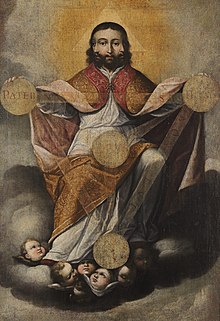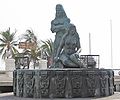Colombian art
| Part of a series on the |
| Culture of Colombia |
|---|
 |
| Society |
| Topics |
|
| Symbols |
Colombian art has 3500 years of history and covers a wide range of media and styles ranging from Spanish
Pre-Columbian sculpture
Pottery
There is archaeological evidence that ceramics were produced on Colombia's Caribbean coast earlier than anywhere in the Americas outside of the lower

Goldwork
The earliest examples of gold craftsmanship have been attributed to the Tumaco people of the Pacific coast and date to around 325 BCE. Gold would play a pivotal role in luring the Spanish to the area now called Colombia during the 16th century (See: El Dorado).
One of the most valued artifacts of Pre-Columbian goldwork is the so-called
The
Stone
Roughly between 200 BCE and 800 CE, the San Agustín culture, masters of stonecutting, entered its “classical period". They erected raised ceremonial centres, sarcophagi, and large stone monoliths depicting anthropomorphic and zoomorphhic forms out of stone. Some of these have been up to five meters high.
Related to the San Agustín culture were the inhabitants of Tierradentro (“inner land”, so called because of its inaccessibility) who created over one hundred and fifty underground tombs, or hypogea; their walls and ceilings were richly decorated with geometric forms recalling the interior of palm huts. Also in the tombs were found funeral urns, bowls, and pitchers.
-
Tolita-Tumaco gold figure
-
TheMuisca (Pasca, Cundinamarca), gold, 600 CE - 1600 CE
-
El Infiernito archaeological site
-
ZoomorphicSan Agustin sculpture
-
Monumental tomb, Middle San Agustín period (San Agustín, Huila), 100 BCE - 700 CE
Modern sculpture
The Colombian sculpture from the sixteenth to 18th centuries was mostly devoted to religious depictions of ecclesiastic art, strongly influenced by the Spanish schools of sacred sculpture. During the early period of the Colombian republic, the national artists were focused in the production of sculptural portraits of politicians and public figures, in a plain
-
Monument to thetayrona deities. Santa Marta
-
Monument to India Catalina in Cartagena
-
Vargas Swamp Lancers Memorial is the largest sculpture in Latin America
-
Bird ( Byterrorist attack in 1997, Medellínwhere 17 people died. The remains of the sculpture are displayed in San Antonio Square as a memorial for the victims
-
Ranas bailando. (Dancing frogs) 1990. By María Fernanda Cardoso
-
Cascada. ByEdgar Negret
Painting
Pre-Columbian period
-
Chimitápetrographs, circa 1300 B.C. Santander Department
Colombian colonial art includes altar wood carving masterpieces and the statues for religious processions.
Colonial period
Painting in the colonial period reflected the power and prestige of the Catholic Church and the Spanish aristocracy in Colombia or as it was then known The New Kingdom of Granada (c. 1548-1717) and later The Viceroyalty of New Granada (1717–1819).
Early colonial period
Colombian painting in the early colonial period (1530s–1650) was mostly ecclesiastical in subject and based on
Spanish explorers first set foot on Colombian soil in 1499 and established
Workshops in
The churches and homes of wealthy families in the main towns of
The first colonial-era painter to work in Colombia, or as it was then known as,

Baroque period
Baroque art (starting in Rome around 1600), including
Another Seville native, Baltasar de Figueroa El Viejo (1629–1667), settled in Bogotá in the early 17th century and set up an artist's workshop. He and his many descendants would be prolific and would invent a kind of creolized Colombian form of Baroque painting that combined the borrowing of forms and subjects from European engravings (mostly religious in nature: saints in various states of mortification or ecstasy, the Virgin Mary, or Christ) with native motifs and decoration. But it would be one of the Figueroa family's apprentices, Gregorio Vázquez de Arce y Ceballos, who would stand out among all painters of the colonial era.
The
-
San José y el Niño byGregorio Vasquez de Arce y Ceballos, oil on wood, ca. 1670
-
St. Catalina weddings by Gregorio Vasquez de Arce y Ceballos, (Desposorios de Santa Catalina) 18th century. Oil on canvas 176 x 130 cm
-
Holy Trinity, by Gregorio Vásquez de Arce y Ceballos. Oil on canvas.62 x 44 cm
-
"Coronación de la virgen", by Baltasar de Vargas Figueroa (1663) – The catholic influence is very strong in the colonial period
-
Sopo Archangels, a series of archangels painted around 1650 in colonial Colombia.
-
Baraquel- Blessing of God: The archangel of virtue
-
Guardian Angel-Company of God: The angel of children
-
Esriel-Justice of god: The archangel of divine discipline
The Virreinato and rococo
The raising of the Viceroyalty of New Granada in 1717 coincided roughly with the ascension of the Bourbons to the throne of Spain. This period marked a period of resurgence and the first sparks of
Republican period
-
Policarpa Salavarrieta portrait by Mercedes Delgado Mallarino
-
Portrait of Francisco de Paula Santander (1874) by Martín Tovar y Tovar (1827-1902). Oil on canvas
-
Portrait of Joaquín Mosquera by Ricardo Acevedo Bernal (1867)
20th century and modernism
From 1920 to 1940,
Several art critics point to the 1950s as the time when Colombian art started to have a distinctive point of view, reinventing the traditional elements under the 20th century concepts. Examples of this are the Greiff portraits by Ignacio Gomez Jaramillo, showing what the Colombian art could do with the new techniques applied to typical Colombian themes. Carlos Correa, with his paradigmatic “Naturaleza muerta en silencio” (silent dead nature), combines geometrical abstraction and
-
Chicago fair (1933), bySantiago Martinez Delgado
-
Mural by Santiago Martinez Delgado in the Colombian Congress
-
"The Colombian Republic". Mural by Pedro Nel Gómez
-
"Coffee dance". Mural by Pedro Nel Gómez
-
"Painting of a contrabass" byAlvaro Valbuena(1970)
-
Zibebiz. Omar Rayo. Quinta de San Pedro Alejandrino
21st century
During the 21st century, Colombian artists have focused in the intersection between new media and traditional crafts, as well as narratives that reflect on the Colombian conflict and the consequences it has had on Colombian society, territory and bodies.[7][8]
-
"Fourth Circle" by Nicolas De la Hoz, oil and acrylic on canvas, 2005
Film
Theater
Theater was introduced in Colombia during the Spanish colonization in 1550 through zarzuela companies. Colombian theater is supported by the Ministry of Culture and a number of private and state owned organizations. Among the most important organizations are the National Association of Scenic Directors (ANDE), Performing Arts Workers Associations, Antioquia Storytellers Association, Colombian Association of Critique and Theater Research (ACIT), Puppeteers Associations (ATICO), Colombian Corporation of Theater among others.
Colombian theater was introduced during the
Dance
This section is empty. You can help by adding to it. (July 2010) |
See also
- Muisca art
- Colombian handicrafts
- List of Colombian artists
- Culture of Colombia
- Colombian architecture
- Latin American culture
- Art Galleries in Colombia
References
- ^ Armitage, Helen (28 May 2014). "The Art of Fernando Botero: Colombia's 'Most Colombian' Artist".
- ISBN 0-8173-0552-1.
- ISBN 0-306-46259-1.
- ISBN 0-12-557180-1.
- ISBN 978-1-904832-77-5.
- ^ "Mary0007.HTM". Archived from the original on 2013-07-15. Retrieved 2007-09-14.
- ^ "Arte Contemporáneo Colombiano". 23 October 2013.
- ^ "PASADO TIEMPO FUTURO. Arte en Colombia en el siglo XXI".
Further reading
- Londoño Vélez, S. (2001). Colombian Art: 3,500 Years of History. Bogotá: Villegas Editores
External links
- (in English) Official site - Gold Museum, Bogotá
- (in English) Virtual museum of Pre-Columbian gold in Colombia
- (in English) Current information on Colombia´s Art Scene
- (in Spanish) Official site Museo de Bogotá Archived 2008-05-16 at the Wayback Machine
- (in Spanish) Official site Museo de Arte Moderno de Bogotá
- (in Spanish) Digital collection Archived 2010-09-23 at the Wayback Machine - Luis Ángel Arango Library
- (in Spanish) Official site Directorio Nacional de Arte Colombiano
- (in Spanish) Museum of Antioquia

































